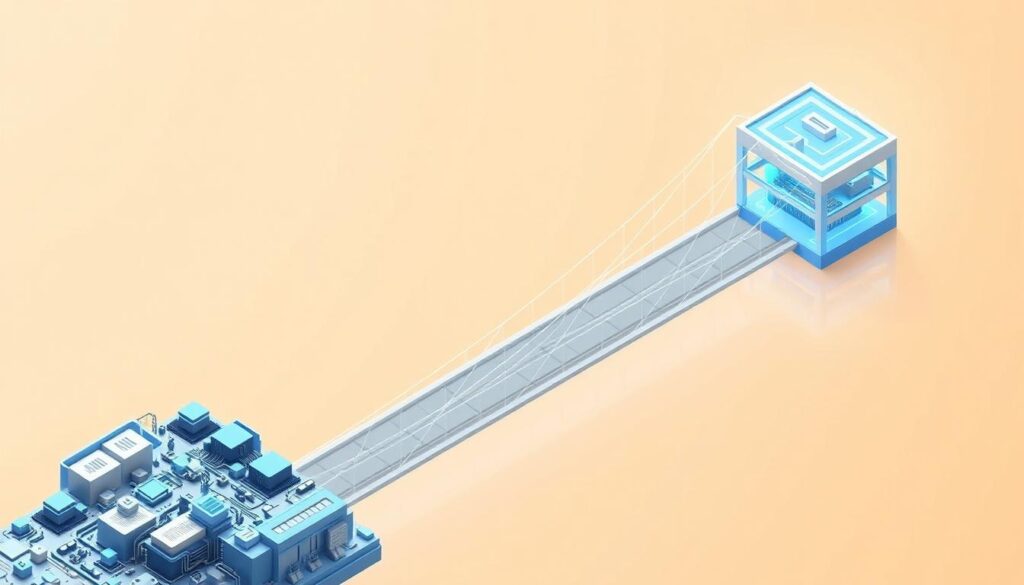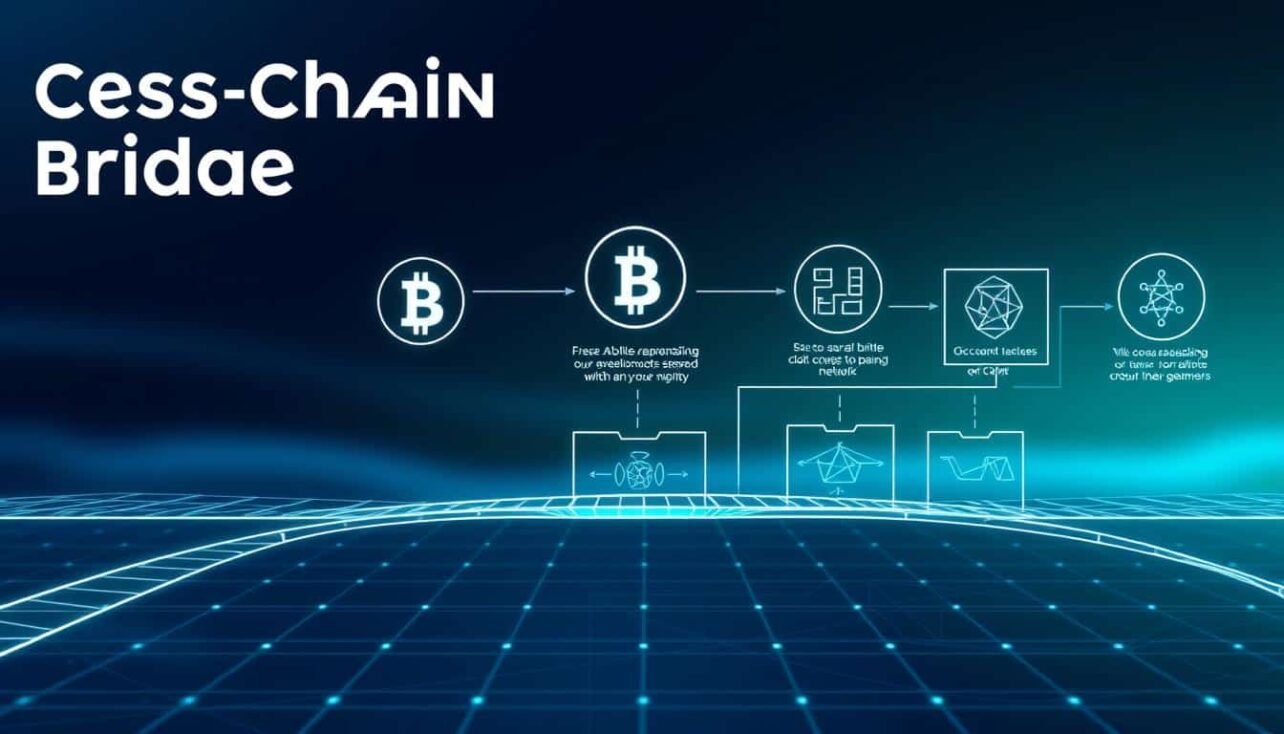This ultimate guide demystifies how a bridge works across different blockchain environments. It is written for readers in the United States who want a clear, practical view of interoperability in today’s multi‑chain ecosystem.
The Web3 world now spans hundreds of networks and layer‑2s, each with unique security and trust models. Without shared standards, isolated economies limit users from moving tokens and data freely.
Here we introduce how messaging and token transfer protocols emerged to connect these networks. You will get a plain‑language look at mechanisms that lock, burn, mint, or unlock assets so value moves between chains.
The guide previews benefits, known risks from past exploits, and enterprise use cases for settlement and payouts. It also provides a practical framework to compare bridges by trust, speed, cost, and coverage, and links to further reading like this education hub.
Why Interoperability Matters in a Multi‑Chain DeFi Ecosystem
Today, dozens of independent blockchain networks and layer‑2 solutions split assets and liquidity across isolated markets. This fragmentation forces users to manage multiple wallets, relay tools, and routing steps just to move funds or access services.
Interoperability lets smart contracts read and write data across separate blockchains. It enables applications to orchestrate logic across environments and to pool liquidity for deeper, more efficient markets. Developers gain new composability and can build designs that span ledgers without rebuilding core features.

- Less friction for users: fewer manual transfers and simpler UX.
- More liquidity: aggregated pools reduce slippage for traders.
- Faster innovation: teams reuse specialized execution environments.
| State | Impact | Outcome |
|---|---|---|
| Fragmented networks | Isolated assets and apps | Low liquidity, high user friction |
| Interoperable stacks | Shared data and value flows | Deeper markets, faster innovation |
| Reliable plumbing | Abstracted UX with security | Broader reach for applications and more value for users |
Bridges and messaging systems are the foundation for this interoperability. They introduce new assumptions and risks, so design and governance matter. When done right, robust connectivity converts isolated ledgers into a cohesive ecosystem and unlocks greater value for everyone.
What Is a Cross‑Chain Bridge in Blockchain Networks
A bridge is middleware that connects independent blockchain domains so value and information can move between them.
It does not move native balances directly from one chain to another. Instead, a smart contract on the source will lock or burn assets, while a corresponding mechanism on the destination will mint or unlock representative tokens.

- Attestation: validator sets, relayers, or light clients attest to source events for destination execution.
- Evolution: many bridges began as wrapped-asset systems and now support general message passing.
- Choices matter: selected protocols affect security assumptions, latency, and cost.
| Feature | Token-only | Message-capable |
|---|---|---|
| Primary use | Move tokens | Move tokens + calls |
| Complexity | Lower | Higher |
| Application flow | Simple transfers | Composable cross‑ledger logic |
Bridges are critical infrastructure in a multi‑ledger world. Design choices and verification standards aim to reduce fragmentation while keeping verification robust.
Bridge Transfers vs. Centralized Exchange Transfers for Users
For many users, moving assets once meant using an exchange as an intermediary — a multi‑step detour that adds time and cost.
Legacy CEX path: deposit, trade for a compatible token, then withdraw to the destination. Each step can add withdrawal charges, trading fees, and waiting windows.
Direct on‑chain transfer: a single on‑chain transaction with a bridge compresses that route into one step. That often lowers total fees and keeps the user self‑custodial, so private keys stay with the user.

- Fewer fees overall by avoiding multiple conversions and exchange withdrawal costs.
- Faster visibility: status is on‑chain, not stuck in an exchange queue.
- Self‑custody preserves control and reduces counterparty risk.
| Path | Cost | When preferable |
|---|---|---|
| Exchange (deposit → trade → withdraw) | Higher (trades + withdrawals + slippage) | Off‑ramp to fiat or unsupported destinations |
| Single on‑chain transfer | Lower (one set of fees) | Keep same asset representation and faster settlement |
| Notes | Price slippage risk | Evaluate operator audits and uptime |
Bridges improve UX and value movement across chains, but they carry risks. Users should vet operators, check audits, and pick the path that fits their final use case.
How Do Cross‑Chain Bridges Work across Different Blockchain Networks
A typical transfer starts when a user signs a transaction on the source chain that requests value or data move to a destination chain.

Source chain to destination chain: the message and value flow
The process follows a few clear steps. First, on the source chain a bridge contract will lock or burn tokens. Next, an attestation is created and sent to the destination chain. Finally, the destination-side contract mints or unlocks the representation for the recipient.
Smart contracts, relayers, and messaging
Smart contracts and contracts on both ledgers handle custody and issuance. Relayers or validator sets observe events, bundle proofs, and submit them so the destination acts only on valid source events.
Fees, latency, and confirmation windows
Costs include base gas, relayer fees, and protocol fees. Designs wait for block confirmations to avoid reorgs; more confirmations mean better security but higher latency. Monitoring tools expose each step so users and developers can track progress.
| Component | Role | Impact |
|---|---|---|
| Bridge contracts | Lock/mint | Custody & issuance |
| Relayers/validators | Attest events | Trust & speed |
| Messaging | Deliver proofs | Finality window |
Summary: smart contract logic, relayers, and messaging combine to move value between blockchain networks reliably, balancing cost, security, and speed across the flow.
Types of Cross‑Chain Bridges and Token Movement Models
Token movement models set trade‑offs for security, speed, and developer flexibility when moving assets. Each model changes who holds custody, how proofs are verified, and the expected user experience.
Lock and mint
In this model the original token stays on the source ledger while a wrapped representation is minted on the destination. Custody risk concentrates in a source vault, so audits and transparency matter.
Burn and mint
The source token is destroyed and a native token is re‑issued on the destination. This reduces custodial exposure but requires reliable, tamper‑resistant proofs of burn.
Lock and unlock (liquidity pools)
Transfers use destination pools to unlock pre‑existing balances. This gives speed when liquidity is deep, but imbalanced pools can cause slippage or delays.
Programmable message passing
Some systems combine token movement with arbitrary messaging so a transfer can trigger swaps, deposits, or staking in one flow. That enhances developer ergonomics and functionality, but adds complexity.
- Trade‑offs: custody vs. verification, speed vs. liquidity depth.
- Developer note: pick the model that fits asset policy, cost targets, and UX expectations.
| Model | Primary benefit | Key risk |
|---|---|---|
| Lock & mint | Flexibility | Custody concentration |
| Burn & mint | Asset integrity | Proof robustness |
| Lock & unlock | Speed with liquidity | Slippage / pool imbalance |
Benefits: Liquidity, Asset Productivity, and Interoperability for Applications
Pooling resources across multiple networks lets users and applications find tighter spreads and faster execution.
By aggregating liquidity, markets become deeper. That improves price discovery and reduces slippage for traders and apps. Deeper pools also let arbitrageurs smooth volatility, which improves overall execution quality.
Moving assets to where yields, collateral use, or functionality is best raises asset productivity. Holders can unlock more value by shifting an asset to lending, staking, or specialized vaults.
Backends that hide routing and settlement create a single, chain‑abstracted user flow. The front end shows one smooth experience while the system handles transfers across networks behind the scenes.
- Multi‑app workflows: lending, DEX swaps, and staking can be stitched together by message flows so a single action triggers multiple steps.
- Enterprise rails: one payout rail to many networks simplifies treasury, reporting, and compliance for large organizations.
- Healthier markets: better liquidity boosts price stability and lowers execution costs for everyone.
| Benefit | Impact for users | Impact for applications |
|---|---|---|
| Aggregated liquidity | Lower slippage | Better routing |
| Asset mobility | Higher yields | More composability |
| Abstracted UX | Simple flows | Easier integration |
In short, improved liquidity and asset productivity align incentives across ecosystems. That compounding effect increases adoption by making value easier to move and applications simpler to use.
Security and Risk in Bridges: Lessons from Exploits
High-profile exploits have reshaped how teams and users view interoperability security.
Key compromise vs. logic bugs
Two common failure modes dominate incidents. Key compromise happens when attackers control signing quorums. That was the root of Ronin’s $620M loss.
Logic bugs let attackers mint or bypass checks. Wormhole’s $320M loss came from a missing verification step that allowed wrapped-asset inflation.
Liveness, theft, and upgrade risks
Stopped operators can freeze transfers, leaving value stuck and users uncertain. Operator theft or rushed upgrades can also put users’ funds at risk.
Unprotected upgrades may introduce malicious code or mistakes into live contracts.
Due-diligence checklist
- Long operational history with incident transparency.
- Multiple independent audits and public postmortems.
- Substantial bug bounties and time-locked upgrades.
- Slashable stakes or slashing rules for validators to align incentives.
| Failure mode | Example | Mitigation |
|---|---|---|
| Key compromise | Ronin ($620M) | Multi‑sig, hardware keys, quick rotation |
| Logic bug | Wormhole ($320M) | Formal verification, proof checks |
| Liveness failure | Stalled operator | Watchers, fallback relayers |
Practical advice: read incident postmortems, size transfers, diversify routes, and prefer mature contracts and audited bridges before larger transactions.
Trust‑Minimization, Finality, and Verification across Blockchains
Verifying source history on the destination reduces reliance on intermediaries but raises costs. Trust‑minimized designs verify events directly, often using light clients, so fewer external parties must be trusted.
Trade‑offs along the trust‑minimization spectrum
Stronger verification increases assurance but adds latency and gas costs. That can degrade throughput and user experience.
Weaker attestations like multisig or validator votes are faster and cheaper. They rely more on operators and require operational safeguards.
Handling reorgs and destination‑chain finality
Finality mismatches matter. If a reorg on the source chain happens after a mint on the destination chain, token balances can become unbacked.
Mitigations include waiting for deeper confirmations, using finality gadgets, or requiring light‑client proofs before execution.
- Smart contract safeguards: timeouts, dispute windows, and rollback checks.
- Monitoring and fallback: alerting, secondary relayers, and paused upgrades.
- Match design to risk: high‑value transfers favor heavier verification for better security.
| Verification | Speed | Security profile |
|---|---|---|
| Validator attestations / multisig | Fast | Operationally dependent |
| On‑chain light‑client proofs | Slower | Stronger, cryptographic |
| Hybrid (confirmations + attestations) | Balanced | Flexible, lower single‑point risk |
Cross Chain Bridge Protocols Explained
A unified interface makes sending tokens and messages feel predictable across many ledgers.
Modern protocol suites expose a small set of primitives—send, receive, and verify—that developers call instead of building custom adapters for every destination.
These standards aim to balance security, cost, and operational flexibility. While many projects converge on similar goals, they still differ in operator sets, verification models, and which networks they support.
Interoperability layers often compose with oracles and attestation services to enable richer workflows, like automated settlements or on‑arrival execution.
- Developer tooling: SDKs, runtimes, and clear docs speed safe adoption.
- Heterogeneous support: adapters permit EVM and non‑EVM integration via standard endpoints.
- Selection signals: protocol maturity, audit history, and past incidents matter for risk decisions.
| Focus | Benefit | Trade‑off |
|---|---|---|
| Standard primitives | Faster development | One-size may not fit all cases |
| Composed services | Richer flows | More attack surface |
| Maturity & audits | Lower operational risk | Slower innovation |
Understanding these shared mechanics helps teams weigh trade-offs across vendors and pick the right approach for different blockchain networks and production needs.
The 2025 Bridge Landscape: Major Players and Protocols
Major vendors now compete on coverage, security, and cost, shaping which rails enterprises pick for settlement. Below is a concise survey of the projects that matter in 2025 and how they differ on safety, throughput, and fees.
Chainlink CCIP and the Risk Management Network
Chainlink CCIP targets enterprise use with pooled oracle-plus-validator security. Its Risk Management Network flags anomalous patterns before settlement, focusing on security and predictable fees.
IBC and light-client security in Cosmos
IBC relies on light clients for verification inside the Cosmos ecosystem. It connects 115+ zones and moves roughly $700M in monthly volume, favoring cryptographic finality over operator trust.
LayerZero, Stargate, Axelar, and Wormhole
LayerZero/Stargate uses a DVN model and wide coverage; Stargate reports ~ $370M TVL and support for 40+ chains.
Axelar focuses on GMP between EVM and Cosmos zones with ~ $320M TVL and strong developer tooling.
Portal (Wormhole) holds near $3B TVL and about $1.1B monthly volume. Its guardian model is fast but remember past exploits when sizing transfers.
Liquidity networks and novel settlement layers
Across is optimistic and UMA‑backed, with ~ $98M TVL and ~$1.3B 30‑day volume, built for fast settlement on many networks.
cBridge runs a liquidity-router model (~ $67M TVL, 40+ chains) that balances speed and routing complexity.
deBridge uses a near “0‑TVL” order‑book approach (~ $12M TVL; ~$793M 30‑day volume) that reduces idle capital but leans on market makers.
Allbridge Core holds ~ $23M TVL and targets simple transfers across many endpoints.
Everclear (ex‑Connext) acts as a clearing layer designed to lower costs and tighten settlement fees.
| Project | Design focus | TVL / Volume |
|---|---|---|
| Chainlink CCIP | Enterprise & risk monitoring | — / — |
| IBC | Light‑client security | ~$700M monthly |
| Portal (Wormhole) | Wide coverage, guardian validators | ~$3B TVL / ~$1.1B monthly |
| Stargate | Deep routing, DVN model | ~$370M TVL |
Takeaway: pick a provider that matches your risk tolerance. For high‑value transfers prefer heavier verification; for fast, low‑fee moves, consider liquidity routers or clearing layers. Always size transactions and monitor on‑chain status for each transaction to manage value safely.
Deep Dive: Chainlink CCIP Functionality and Design
Chainlink’s CCIP groups message routing, fee handling, and token flows under a single developer‑friendly surface. The design separates responsibilities so teams can pick custody and verification patterns that match their risk profile.
Routers, OnRamp/OffRamp contracts, and token pools
The Router is the entry point that coordinates message delivery and execution across endpoints. It works with OnRamp and OffRamp contracts that perform local checks and authorize final actions.
Token pools hold or interact with tokens for each route. Access control on pools limits who can mint, burn, lock, or unlock assets to reduce operational risk.
Burn & mint, lock & mint, and lock & unlock in CCIP
CCIP supports three transfer models so projects may choose by standard and custody needs. Options include burn & mint, lock & mint, and lock & unlock via liquidity pools. That flexibility helps integrate diverse asset standards while keeping developer ergonomics simple.
Early‑access scope, supported networks, and fees
Early Access covers major EVM mainnets like Ethereum, Optimism, Arbitrum, Polygon, Avalanche, BNB Chain, and Base. A Risk Management Network independently monitors flows and flags anomalies to improve overall security.
Fees are commonly paid in LINK and should be modeled during integration so UX remains predictable. Sender smart contract patterns let applications initiate transfers and handle fee flows programmatically.
Summary: CCIP combines programmable messaging with token movement to make end‑to‑end workflows more reliable, giving teams a flexible rail for value and logic across ledgers while retaining strong operational controls.
| Component | Role | Benefit |
|---|---|---|
| Router | Coordinate messages | Single entry for execution |
| OnRamp/OffRamp contracts | Authorize local actions | Controlled execution |
| Risk Management Network | Monitor anomalies | Improved security posture |
Comparing Approaches: CCIP, IBC, and Other Cross‑Chain Protocols
Not all connection models use the same trust assumptions, and that changes how teams integrate networks.
IBC uses on‑chain light clients for cryptographic verification. That delivers a trust‑minimized design but requires deeper integration into each blockchain’s runtime. It fits best when full protocol-level guarantees and tight finality matter.
CCIP relies on adapter patterns and Chainlink infrastructure. Its oracle-backed layers add observability and risk monitoring. That model trades slightly higher operational complexity for broader coverage across EVM and non‑EVM networks.
Other services like Wormhole, Axelar, and LayerZero make different trade‑offs. Some prioritize speed and low fees using validator attestations. Others emphasize SDK maturity and developer ergonomics for generalized messaging and composable flows.
- Integration: IBC needs protocol changes; CCIP and others add adapters.
- Security: light clients give cryptographic guarantees; oracle or validator models rely on operator sets and monitoring.
- Functionality: generalized messaging and SDKs vary in maturity and observability.
| Approach | Security model | Coverage & speed | Developer ergonomics |
|---|---|---|---|
| IBC | Light‑client verification (cryptographic) | Deep integration, slower to add new networks | Native support inside Cosmos SDK; high assurance |
| CCIP (adapter) | Oracle‑backed + validators; monitoring | Fast onboarding across many EVMs and beyond | Rich SDKs, strong observability and risk tools |
| Validator/attestor models (Wormhole, Axelar) | Operator attestations (faster) | Broad coverage, quick additions | Good SDKs, but different trust assumptions |
The right selection depends on target blockchains, required functionality, and acceptable security vs latency trade‑offs. No single approach wins for every use case; many teams mix providers to balance cost, coverage, and operational limits.
Bridge Aggregators vs. Bridges: Routing Liquidity across Networks
A meta‑layer can inspect dozens of routes and pick the best path for a single transfer in real time.
Definition: an aggregator is a service that selects among multiple bridges to deliver a requested transfer. It evaluates route cost, available liquidity, and estimated finality to return a single, user‑facing flow.
Routing decisions weigh destination coverage, on‑route liquidity, transaction gas, and total fees. Aggregators favor paths with deep liquidity and faster confirmation windows to reduce slippage and wait time.
Developer gains: faster integrations via SDKs like LI.FI and Socket, fewer edge cases, and automatic fallbacks when a route is congested. That speeds product launches and simplifies error handling.
- Improved UX: one cohesive flow for users instead of manual selection.
- Dynamic rebalancing: avoid thin pools or high‑fee legs in real time.
- Operational note: aggregators inherit the risk models of underlying bridges and must disclose route properties.
| Factor | What it affects | Why it matters |
|---|---|---|
| Liquidity | Slippage | Deeper pools lower cost |
| Fees | Final amount | Choose low‑fee hops |
| Finality time | Speed | Fewer reorg risks |
Bottom line: for many teams, aggregators are the fastest way to deliver robust cross‑network transfers with minimal overhead while keeping price and speed optimal.
Building with Bridges: A Developer Playbook
Teams building multi‑ledger flows need a clear sender design, liquidity plan, and observability to operate reliably in production.
Sender contracts, access control, and smart contracts
Design a sender contract that securely encodes messages, approves token movement, and pays fees when calling router functions. Keep calls atomic where possible to avoid partial state changes.
Access control should follow least‑privilege: split mint/burn authority, limit operator keys, and use timelocks for upgrades.
Liquidity planning, pool management, and slippage
For pool‑based routes, define target balances and a rebalancing cadence. Set slippage guards to keep execution predictable for users.
- Target balances by volume and expected routing share.
- Automated rebalances during low‑fee windows.
- Onboarding rules for market makers to reduce idle capital.
Monitoring events, webhooks, and backend UX updates
Subscribe to DepositInitiated and MessageExecuted events. Webhooks and unified RPCs let backends update UX with timely transaction status and estimated finality.
Build dashboards that surface route health, observed network latency, and aggregated fees so users see realistic expectations.
| Focus | Action | Benefit |
|---|---|---|
| Retries & idempotency | Design replay-safe handlers | Safe recovery from partial failures |
| Testing | Canary transfers & staged rollouts | Catch regressions before scale |
| Infra | Unified RPC providers | Consistent multi‑chain reliability |
Final tip: automate small test transfers, monitor route health, and iterate policies before enabling large volumes. That practice reduces surprises and improves long‑term functionality for every use case.
Enterprise Settlement and Stablecoin Transfers across Chains
A single, auditable payout rail lets enterprises move payroll, refunds, and vendor payouts across multiple blockchain networks while keeping treasury and compliance logic centralized.
Stablecoin models such as burn‑and‑mint enable native issuance on the destination. That pattern reduces wrapped‑asset custody risk and preserves on‑ledger value semantics for recipients.
Enterprises favor deterministic fees and predictable finality for business flows. A reliable network for routing payouts simplifies reconciliation and enforces corporate policy across endpoints without bespoke integrations.
Operational benefits include centralized controls, faster reconciliation, and auditable workflows. Programmable settlement can trigger downstream actions on receipt, like crediting merchant balances or releasing goods.
Security expectations at scale demand segregation of duties, real‑time monitoring, multi‑party approvals, and immutable logs for audits. Service level agreements (SLAs) and deterministic fee models are essential for payment applications.
- Supported production networks: Polygon, Base, Optimism, Avalanche.
- Example rails: CCIP for PYUSD routing and CCTP-style burn/mint for USDC native issuance.
To evaluate compatibility and reach, teams should review route coverage and integration guides like cross‑chain compatibility before deployment.
User Experience Trends: Chain‑Abstracted Wallets and Account Abstraction
Smart wallets are making multi‑network transfers feel like a single, simple action for end users.
Chain abstraction hides underlying rails so a user interacts with one coherent flow, regardless of where settlement happens. This removes wallet toggles and reduces onboarding friction for people new to the space.
Account abstraction adds features like gas sponsorship and batched execution that let one signed call handle multiple on‑ledger steps. Paymasters and session keys keep operations safe without constant prompts.
Modern wallets coordinate background routing and on‑demand bridging to pick optimal endpoints. The front end stays minimal while the backend handles fees, liquidity, and finality across networks.
- Safety tools: session keys, paymasters, and policy engines restrict actions and reduce phishing risk.
- UX signals: clear status messages and receipts tell users when a transaction completes on the destination.
- Mobile focus: biometric auth and compact flows cut friction for everyday transfers.
| Feature | Benefit | Why it matters |
|---|---|---|
| Gas sponsorship | Simpler payments | Removes need for users to hold native tokens |
| Batched execution | Fewer steps | One signature triggers multiple operations |
| Observability | Trust | Reduces confusion during delays |
Outlook: as infra and observability improve, invisible bridging will become the norm and user flows will feel native across many chains while preserving clear receipts and controls.
Which Bridge Design Should You Use for Your Use Case
Choose a transfer path based on how much value moves, how fast you need finality, and which networks are supported.
Small transfers should favor speed and smooth UX. Fast routes reduce friction and often cost less in total fees. Accepting higher operational trust is reasonable for trivial amounts.
Large transfers demand stronger security. Prefer designs that use cryptographic verification or multi‑party custody. That lowers the risk of loss even if latency increases.
Consider the token model. If mint/burn permission exists, burn‑and‑mint reduces custodial exposure versus wrapped assets. Check whether your asset can be reissued on the destination chain before choosing a route.
Always verify supported destinations and route depth across different blockchains to avoid thin liquidity or stalled flows. Compare total cost, confirmations expected, and historical reliability for each source chain to destination chain pairing.
- Use aggregators to diversify protocol risk and pick the lowest‑cost path automatically.
- Model worst‑case delays and plan fallbacks like alternate routes or refunds on the source.
- For enterprise or compliance use, enforce strict audit trails, timelocked upgrades, and clear governance.
| Design | Security | Latency | Best use |
|---|---|---|---|
| Light‑client verification | High | Higher | Large value transfers |
| Validator attestations | Medium | Low | Fast, low‑value moves |
| Liquidity router / aggregator | Variable | Low | UX-first transfers |
Bottom line: match security, latency, cost, and token permissions to your intended use. Size transfers and pick fallback routes to reduce surprises in production.
Conclusion
Well‑designed rails let applications stitch workflows across ledgers while keeping user experience simple and auditable. ,
Interoperability lifts isolated systems into a cohesive ecosystem that amplifies value through efficient capital and data flows.
Today, secure bridges and messaging protocols are mission‑critical infrastructure for modern blockchain apps. Favor audited, transparent operators and learn from past incidents to protect funds and reputation.
Practical steps: use aggregators, monitor route health, and build robust observability so users see clear status and recover from failures. Diversify routes to balance cost, speed, and assurance.
Prototype with current tooling and follow standards as they mature. Thoughtful adoption of these rails positions teams to lead the next wave of Web3 growth—see this cross‑network primer for further reading.
FAQ
What is the main purpose of a cross‑chain bridge in blockchain networks?
A bridge lets users move value and data between different blockchains so applications on one network can use assets from another. It enables token transfers, liquidity routing, and message passing that power multi‑chain DeFi, NFT marketplaces, and enterprise settlements.
How does a transfer from a source chain to a destination chain typically flow?
The user initiates a transaction on the source chain where a smart contract locks or burns the asset. Relayers or oracle services observe that event, submit a proof or message to the destination network, and a contract there mints, unlocks, or releases the corresponding token or funds to the recipient.
What roles do smart contracts and relayers play in bridging?
Smart contracts enforce the lock, burn, mint, or unlock logic on each network. Relayers or verifiers monitor events and transport messages or proofs between networks. Together they form the trust and execution layer that moves assets and verifies state across chains.
How do fees, latency, and confirmation windows affect users?
Users pay fees for on‑chain gas, relayer or oracle services, and sometimes protocol routing. Latency depends on source chain finality and relayer speed, so transfers can take seconds to minutes or longer. Many bridges require multiple block confirmations to reduce reorg risk before releasing funds.
What are the common token movement models used by bridges?
Common models include lock & mint (custodial lock of native asset and minting a wrapped token), burn & mint (re‑issuance of native units on destination), and lock & unlock via liquidity pools where existing liquidity is swapped and settled. Some systems also support general message passing for programmable transfers.
What security risks should users and developers watch for?
Key risks include private key or validator compromise, smart contract logic bugs, flawed upgradeability, and insufficient decentralization of relayers. Protocol design, audits, bug bounties, and on‑chain monitoring reduce risk but cannot eliminate it—so due diligence matters.
How do bridges handle chain reorganizations and finality differences?
Bridges often wait for multiple confirmations on the source chain or use light clients and finality proofs to reduce reorg exposure. Some protocols tune confirmation windows per network to balance speed and safety depending on the source chain’s finality guarantees.
What trade‑offs exist along the trust‑minimization spectrum?
More trust‑minimized designs (light clients, threshold signatures) reduce centralized control but raise complexity and on‑chain cost. Simpler models rely on federations or custodians that are faster and cheaper but require stronger trust and operational security.
Which major systems and approaches are prominent in 2025?
Leading approaches include Chainlink CCIP for an oracle‑driven mesh, IBC for Cosmos ecosystems with light‑client security, and messaging/asset-focused services such as LayerZero, Axelar, and legacy systems like Wormhole. Several aggregators and bridges like Connext, cBridge, and deBridge continue to route liquidity.
How do bridge aggregators differ from individual bridges?
Aggregators route transfers across multiple underlying bridges and pools to find better price, liquidity, or faster paths. They reduce fragmentation and slippage for users by splitting or rerouting transactions across several providers.
What should developers consider when building with bridges?
Developers must design sender and receiver contracts, manage access controls, plan liquidity and slippage, and implement monitoring and UX flows that handle pending states and refunds. Testing across networks and planning for upgrades are also critical.
Are transfers via centralized exchanges a safe alternative?
Centralized exchanges can be faster and simpler for users who trust custodial services, but they require off‑chain custody and KYC. On‑chain bridges preserve self‑custody and composability with DeFi, at the cost of protocol risk and potentially higher complexity.
How do enterprise stablecoin transfers and settlement use bridges?
Enterprises use bridges and settlement rails to move stablecoins across networks for treasury management, cross‑border payments, and interledger settlement. They favor high‑assurance designs, audited contracts, and protocols with strong liquidity and regulatory clarity.
What red flags indicate a risky bridge or protocol?
Warning signs include opaque operator models, single points of control, lack of audits, unaddressed upgrade mechanisms, thin liquidity, and no public incident history. Check multisig setups, timelocks, and whether independent security reviews exist.
Which bridge designs are best for specific use cases?
For low‑trust asset transfers, use bridges with light‑client verification or robust decentralization. For high throughput and low cost, liquidity‑based or federated solutions may work. For composable DeFi, choose systems that support programmable message passing and token standards across networks.


No comments yet